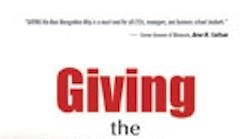If you're planning to cut your employee recognition practices and rewards programs -- then you may as well just liquidate because without a motivated workforce you will soon be out of business. Here's why.
By stopping recognition programs and practices you effectively cut off the human connection between managers and employees. When people are not valued and respected there is a direct reduction in performance and productivity. In manufacturing, a downshift in morale leading to a disengaged workforce can be crippling to meeting production needs, deliverables and staying on schedule.
Manufacturing executives and managers have a responsibility to validate the contributions made by front-line employees by first contractually paying them the agreed rate of pay and benefits. But believing pay alone is enough for employees to be motivated is like stores telling customers that shelves with inventory is enough to keep them coming back. It isn't. Just like stores need to have floor personnel to answer questions and trained staff to move quickly at register lines, companies need to have meaningful employee appreciation programs to keep their workforce motivated, focused and committed. Showing up and clocking in gives the assembly-line a full body count but positive manager communications on a day to day basis creates a front-line who is driven and dedicated every hour of the day.
The only way manufacturing leaders, managers, and immediate supervisors can meet schedules and optimize performance is by learning the importance of expressing positive feedback and appreciation for work done, and recognizing and rewarding their employees' outstanding contributions. The tongue twister of "proper people practices produces performance and profits" has never been truer than in today's economic uncertainty. Without a motivated workforce you won't have profitable businesses.
Proven Research
Jeffrey Pfeffer, a Stanford Business School professor of Organizational Behavior, said, "Companies that manage people right will outperform companies that don't by 30% to 40%." Gallup research also shows that employees who receive recognition are much more likely to be extremely satisfied with their employer. Now here's the clincher for manufacturing managers to remember -- the vast majority of employees who receive recognition or praise feel it motivates them to improve performance thus productivity goes up and schedules are met.
A public sector study showed 97% of managers agreed or strongly agreed that recognition improves morale, and 98% felt recognition improved people's sense of belonging and increased their levels of commitment. Once again, recognition and meaningful recognition by managers to front-line workers has been proven to influence attitudes which directly impacts productivity and results.
Think Recognition Strategy Not Programs
Recognition and rewards can be a strong solution to making businesses successful. However, you must remember that recognition programs are only a tool. Recognition practices are a way of life. Together, programs and practices can be a powerful strategy for retaining and motivating people as well as enhancing productivity and performance.
The key is creating a recognition strategy to define and determine your recognition needs and plan out how you will implement what is right and best for your people, the company and within budget. The 2008 WorldatWork Survey: Trends in Employee Recognition showed only 48 percent of companies actually had a written recognition strategy in place to guide their recognition programs and practices. Interestingly, of those companies who had a recognition strategy 96 percent were aligned with the organization's business strategy. These companies know the value of having a recognition strategy.
This means your recognition practices and programs should work hand in hand in supporting and reinforcing both the business goals and human resources' objectives. Only with this kind of clear direction will recognition and reward programs become an effective leverage point for producing solid business results.
Doing Recognition the Right Way
Too many employees state they don't hear "thank you" enough let alone have their manager or immediate supervisor even acknowledge them by name. So foremost, before any tangibles are given to employees, is the need for respect and common courtesy becoming a standard practice simply because it's the right thing to do.
Employees also share how they're never sure how genuine their boss is when some statement of "good job" or "well done" alone is said. There are questions about the giver's motive and sincerity, and a looming question as to what extra work is coming around the corner. Get rid of using generalities -- a "good job" is a given not an acknowledgment.
Use the "two-part-specificity rule" to overcome any unintentional lack of sincerity. For any spoken or written expression of recognition spell out specifically what it was the person actually did or accomplished. Next, and this often gets missed, is telling the person specifically how their actions made a difference to you personally, or to a customer, or to the company in general.
After interviewing over 2 million employees at 700 companies, one Gallup study showed "most workers rate having a caring boss even higher than they value money or fringe benefits." For example, an operations manager sends a spontaneous email to a supervisor on the shop floor for getting a rush shipment out the night before. But if the manager went out on the floor a few hours later to speak with that supervisor on another matter and said nothing about getting the shipment out, the emailed appreciation would be seen as insincere and would be totally negated. Never lose an opportunity to repeat praise and appreciation. It should also be noted that the Gallup study concluded that how long an employee stays with a company and how productive they are is determined by the relationship they have with their immediate supervisor.
By having a recognition strategy defining your purpose and plans for effectively using your recognition and reward programs and practices, you will guarantee a productive and motivated workforce. And remember the words "thank you" still go a long ways too.
Roy Saunderson is president of the Recognition Management Institute, a strategic recognition consulting and training company. He is the author of GIVING the Real Recognition Way, www.realrecognition.com



